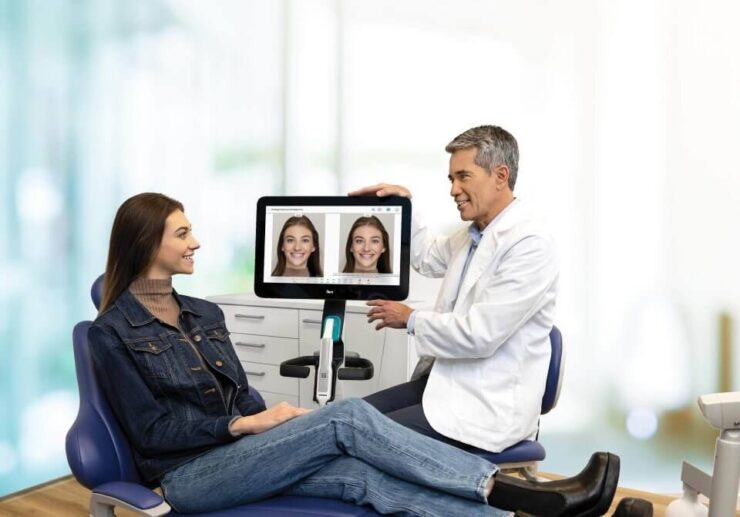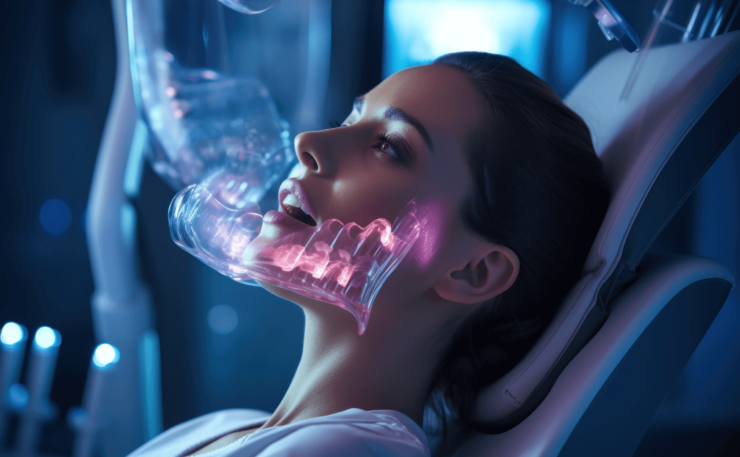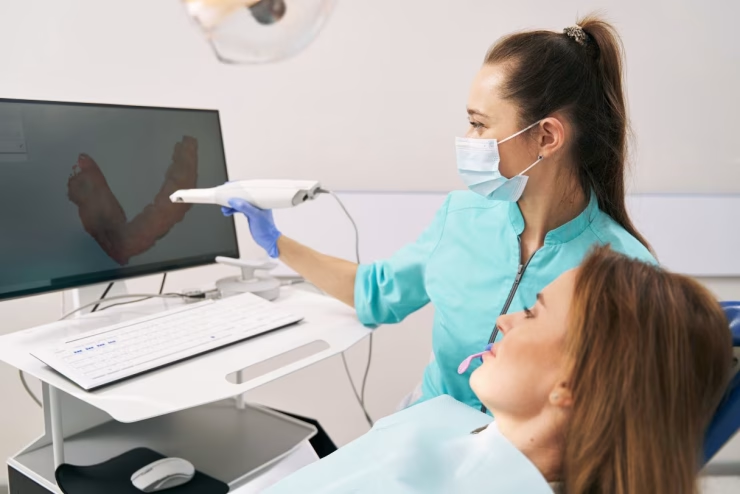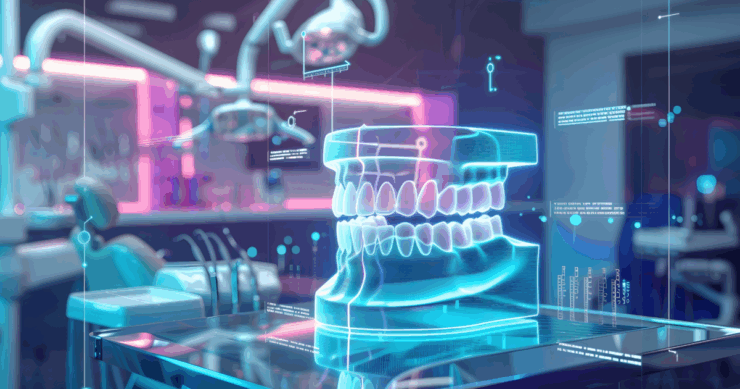Table of Contents
When a patient settles into the chair, heart beating a little faster than usual, everything that happens next matters. The words you choose, the visuals you share, the confidence you portray: they all shape whether that person feels seen, safe, and understood.
As we look ahead, “chairside consultations” will evolve beyond conversation: they’ll become dynamic, data-infused dialogues shaped by algorithms, augmented reality, and empathic automation.
In this article, I explore what the future holds, how we get there, and what it means for you as a clinician who cares about both precision and human connection.
A turning point: the moment when consultation becomes transformation

Think of a typical consultation five or ten years ago. You’d peer at radiographs, sketch on a model, talk a lot, maybe scribble notes mid-chairside. The patient nods along, but you’re never quite sure how much they truly grasp. Fast forward: you wear augmented-reality glasses that superimpose anatomical overlays in your field of view. The patient’s scan shows up as a 3D moving model beside their head. You annotate in real time. Behind the scenes, an AI quietly cross-references similar cases, highlighting risk scores or warning signs. The consultation becomes part of the treatment, not just the prologue.
That shift, from static explanation to immersive co-discovery, is the promise of the future of chairside consultations. It’s not about gadgets for their own sake. It’s about helping each patient feel empowered, reducing guesswork for the dentist, and making decisions that feel shared, not imposed.
How AI, AR, and data converge (and what role “Trust AI” plays)

At the core of this evolution is smart infrastructure: generative AI, augmented reality (AR), connected imaging, and predictive analytics layered over clinical logic.
Imagine: as you review a panoramic scan, an AI overlay highlights suspicious lesions, suggests interpretations, and proposes options – all in your field of view. You toggle between views, include or exclude AI suggestions, and calibrate what you see. When you hand the patient a visualization, it’s not a flat 2D printout – it’s interactive. They can tilt a jawline, toggle caries warnings, or see an animated plan of their future smile.
In many practices today, this works via external AI services that integrate with imaging modules or chairside tools. That’s where platforms like Trust AI come in – acting as the “trusted assistant” behind augmented consults. The name isn’t just marketing: its goal is to make AI visibly transparent and accountable within your consultation, not a “black box” you hide behind.
In such a future, AI doesn’t replace your judgment. It surfaces possibilities. When divergent options arise, the patient and you walk them through together. The outcome? Decisions that are more data-aware, time efficient, and emotionally grounded.
Key innovations transforming chairside consults
Below is a snapshot of major shifts already underway – with real impact for clinics willing to adapt:
| Innovation | What It Enables Chairside | Clinical & Patient Benefits |
| AI-assisted image analysis | Instant detection & flagging of caries, root resorption, bone loss during the visit | Fewer oversights; improved patient trust; documentation support |
| Generative text/voice summary | Auto-draft of clinical rationale or post-consult instructions | Saves precious minutes; ensures consistency |
| AR/VR visualization | Real-time anatomical overlays, surgical previews | Helps patients “see what you see” – reducing anxiety |
| Predictive risk modeling | Risk scores (e.g. periodontal progression, implant failure) | Sharper planning; better informed consent |
| On-the-spot adaptation | Dynamic branching of consult scripts based on patient cues | More personal, less rigid consultations |
One small but telling example: a multinational study found that AI models assessing panoramic radiographs could reliably identify multiple dental findings-across thousands of images-performing at least as well as human readers in many cases. That kind of reliability gives clinicians a second pair of eyes – especially in busy moments.
Overcoming adoption hurdles (and how to do so wisely)
Innovating doesn’t mean discarding your workflow overnight. The smartest transitions are incremental – with attention to people, training, and risk.
Cultural mindset shift
Some team members may feel threatened by AI or worry that it undermines professional judgment. Emphasize that these tools augment rather than override. Encourage early adopters to lead peer learning.
Workflow mapping first
Before buying technology, map your consult workflow: where do patients struggle, where does the clinician hesitate, where are notes incomplete? Target interventions there rather than chasing shiny features.
Validation & oversight
Use AI as suggestive, not definitive. Always review and correct outputs. Over time, you build trust in the AI’s strengths – and guard against its limitations. (One ethics paper argues exactly this boundary: that generative AI must remain under clinician control.)
Data integration & interoperability
Choose systems that speak to your imaging, patient record, and scheduling tools. Siloed solutions burden you later.
Patient transparency
Tell patients when AI is involved, how their data is used, and that final decisions rest with you. Transparency builds trust; hidden tech breeds suspicion.
What changes in your day-to-day practice
You’ll notice new habits emerging:
- Consults will shorten – because much of the “explaining” has already been scaffolded by AI visuals or autogenerated scripts. The extra minutes become time to listen and respond.
- Your documentation will be richer – summaries, rationale, and consent language become part of the consult, not an afterthought.
- Patients will ask better questions – because they see the data and the tradeoffs, not just your “plan.”
- Follow-ups will feel more connected – AI can auto-generate post-treatment care instructions, reminders, check-ins – leaving your team more space to handle the emotional or complex.
- You’ll grow your diagnostic confidence – especially in edge cases or borderline findings, the algorithm’s suggestions act like a colleague you trust.
These changes are neither magical nor gratuitous. There are subtle shifts in where your attention goes – away from mechanics and toward connection, toward nuance, toward oversight rather than manual drudgery.
Safety, ethics, and reliability: guardrails you must keep
Because we’re operating in the human body, trust and responsibility matter more than novelty.
- Bias & generalizability: AI models are only as good as their training data. Regions, ethnicities, and anatomic variants may be underrepresented. Always validate against your local patient population.
- Accountability: No matter how smart an AI is, legal and ethical responsibility stays with the clinician. Never abdicate that.
- Privacy & security: Ensure end-to-end encryption, opt-in consent, and transparent data policies. Patients deserve to know how their scans and data feed AI systems.
- Continuous audit: Routinely review where AI mistakes occurred, track false positives/negatives, and recalibrate your trust boundaries.
- Limit scope: At first, limit AI usage to well-validated domains (radiograph analysis, summary drafting) rather than high-stakes unsupervised decision-making.
Within those guardrails, you can begin to innovate boldly but prudently.
Looking ahead: the human in the loop

The future of chairside consultation isn’t about gadgets, but about refining the human relationship. Tools like AI or AR are powerful – but if they steal your voice, your warmth, or your curiosity, they’ve failed. The real gain comes when a patient leans in and says, “I see what you see,” or “Now I understand why you made that call,” or “I feel confident about going forward.”
That’s the goal. When the tools recede and the human feels clearer.
Years from now, when that patient returns for a different problem, they may remember not the tech you wore, but how you listened, were informed, guided, and human. And that is the future worth building.
If you’d like help imagining a tech adoption roadmap for your specific practice, or want to compare specific systems side by side, I’d be glad to help you sketch that out next.

